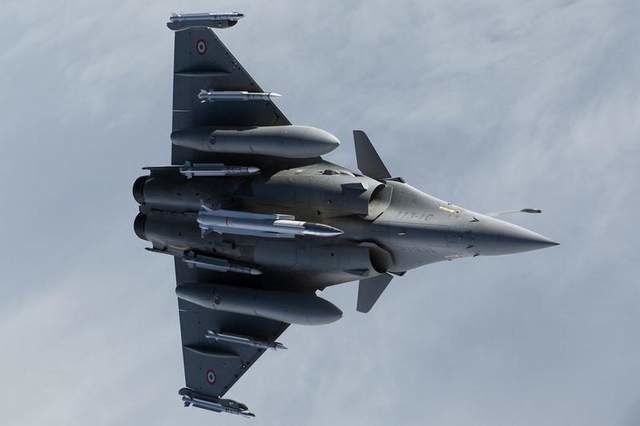Replacement Weapon: A Rafale flies with the air-sol moyenne portée-améliorée nuclear missile. The successor to the missile has been dubbed the ASN4G. (French Defense Ministry)
Nov. 29, 2014 - By PIERRE TRAN – Defense News
PARIS — France has launched studies for an airborne nuclear-tipped missile to replace the current weapon, with the focus on stealth and hypersonic technology on the next-generation atomic arms, Defense Minister Jean-Yves Le Drian said.
The Air Force flies the Dassault Mirage 2000N and Rafale F3 fighters armed with the air-sol moyenne portée-améliorée (ASMP-A) nuclear missile, respectively on the Gascogne and La Fayette squadrons. These are the airborne systems in addition to the four ballistic nuclear missile submarines.
“The studies for the successor to the ASMP-A missile, dubbed ASN4G, have already begun,” Le Drian told a high-level conference on the French nuclear deterrent on Nov. 20. ASN4G is understood to refer to air-sol nucléaire fourth-generation, an industry executive said.
The sensitivity of the deterrent was such that the conference organizer showed an extended video clip of a training mission that obscured an ASMP-A missile carried under the fuselage of a Rafale. A special edition of specialist magazine Air & Cosmos carried a cover picture of a weapon marked ASMP-A under a Rafale. The published pictures are understood to have been adapted by the Air Force to avoid giving too much detail. Air & Cosmos was not available for comment.
Copies of the magazine were distributed at the conference.
“The daring concepts, for example, based on stealth and hypersonic technologies, at the forefront of technological development, will be explored,” Le Drian said.
The projects are key to overcoming the enemy’s interdiction and also for the domestic industrial and technology base, he said.
“The choice of the future weapon system, comprising the ASN4G missile and a platform to be decided, is therefore a major issue for the services,” he said. The project is closely tied to the future format of the Air Force, he said.
Work began in the summer on the ASMP-A, intended to allow the air-breathing missile to defeat future air defense systems out to 2035, Le Drian said. The work consists of design and development studies for the mid-life upgrade, a source said.
Chief of the Air Staff Gen. Denis Mercier previously gave a glimpse of the technology studies on the future airborne weapon, which will call for a choice between stealth or speed.
A stealth study and one on hypersonic speed are underway for the successor to the ASMP-A, Mercier told the defense committee of the lower-house National Assembly in April. The hypersonic weapon might be capable of Mach 7 or 8, he said.
MBDA is prime contractor on the ASMP-A.
Mercier told the parliamentarians he preferred the hypersonic missile.
“It’s the second solution that I prefer,” he said. Mastery of the hypersonic is already a given factor, he said. The U.S., Russia, China, India are looking at the hypersonic technology as they consider a modernization of the airborne nuclear element, with experimental work conducted, he said.
On the future platform carrying the atomic weapon, a choice had to be made on the architecture and performance of the missile, he said. Two options are under study: a new generation fighter, and a bomber.
“The challenge is to select a system able to penetrate defense systems which will be deployed in 20 to 50 years,” he said. The work was also important for the industrial base, he said.
Anti-missile defense has made much progress against ballistic and cruise weapons, he said.
The work on the stealth or hypersonic missile technology will influence development of the future aircraft. For instance, if a hypersonic missile were capable of flying at Mach 7 and were 20 meters long, the aircraft would need to be a large plane, such an Airbus A400M, rather than a fighter such as the Rafale.
commenter cet article …






/image%2F0547456%2F20141007%2Fob_db0dd6_rafale-marine-f3-photo-dassault-avia.jpg)
/image%2F0547456%2F20141007%2Fob_201334_rafale-marine-f3-photo-dassault-avia.jpg)
